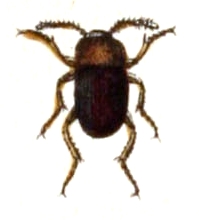
Genus is a taxonomic rank above species and below family as used in the biological classification of living and fossil organisms as well as viruses. In binomial nomenclature, the genus name forms the first part of the binomial species name for each species within the genus.

Hyperolius benguellensis is a species of frog in the family Hyperoliidae. It is found in southern Angola and northern Botswana and Namibia, but other sources cite a wider and more eastern distribution. It is similar to Hyperolius nasutus and have been considered a synonym of that species. Hyperolius benguellensis is not considered threatened.

Hyperolius nasutus is a species of frog in the family Hyperoliidae. Common names include long-nosed reed frog, sharp-nosed reed frog and long reed frog. It is known from northern Angola and northern Botswana, but it presumably occurs more widely. The nominal Hyperolius nasutus was partitioned in 2013 into three cryptic species, the other two being Hyperolius viridis and Hyperolius microps. All these species are members of the so-called Hyperolius nasutus species group, the "long reed frogs".
Pseudophilautus stellatus, also known as starry shrub frog or Kelaart's starry shrub frog, is a frog species in the family Rhacophoridae. It is endemic to Sri Lanka. It was thought to be extinct for 156 years until it was rediscovered in 2009 from the Peak Wilderness, Central Hills of Sri Lanka. This species was previously only known by the lost holotype which was described by Edward Frederick Kelaart in 1853. In 2013, a neotype was designated.

Nargu Wildlife Sanctuary lies on the east side of the Uhl River in Mandi District of Himachal Pradesh. It was notified in 1999 and covers an area of 132.37 km2 (51.11 sq mi). The slopes of the sanctuary are covered with Alpine forest. It is home to various species of animals and birds.

Andinobates is a genus of poison dart frogs from Ecuador, Colombia and Panama. It contains species formerly classified in the genus Dendrobates and in 2006 transferred to the genus Ranitomeya. In 2011 Twomey, Brown, and their colleagues erected the genus Andinobates for a group of 12 species of Ranitomeya. Andinobates frogs can be distinguished from their sister taxon Ranitomeya anatomically in that their 2nd and 3rd vertebrae are fused. They show no limb reticulation, which is present in most species of Ranitomeya.

L. J. Mendis Wickramasinghe is a Sri Lankan herpetologist, taxonomist, naturalist, and wildlife photographer. Inspired by a childhood passion on snakes and by the diversity of his motherland, he has spent over two decades experiencing the forests across Sri Lanka.
Hydnobius is a genus of round fungus beetles in the family Leiodidae. There are about seven described species in Hydnobius.
Pinodytes newtoni is a species of eyeless soil fungivore beetle in the family Leiodidae. It is found in North America.
Catopocerini is a tribe of eyeless soil fungivore beetles in the family Leiodidae. There are at least 2 genera and more than 40 described species in Catopocerini.
Pinodytes gibbosus is a species of eyeless soil fungivore beetle in the family Leiodidae. It is found in California, inhabiting leaf litter.

The Interim Register of Marine and Nonmarine Genera (IRMNG) is a taxonomic database which attempts to cover published genus names for all domains of life, from 1758 in zoology up to the present, arranged in a single, internally consistent taxonomic hierarchy, for the benefit of Biodiversity Informatics initiatives plus general users of biodiversity (taxonomic) information. In addition to containing just over 500,000 published genus name instances as at May 2023, the database holds over 1.7 million species names, although this component of the data is not maintained in as current or complete state as the genus-level holdings. IRMNG can be queried online for access to the latest version of the dataset and is also made available as periodic snapshots or data dumps for import/upload into other systems as desired. The database was commenced in 2006 at the then CSIRO Division of Marine and Atmospheric Research in Australia and, since 2016, has been hosted at the Flanders Marine Institute (VLIZ) in Belgium.

Cholevini is a tribe of small carrion beetles in the family Leiodidae. There are more than 20 genera and 200 described species in Cholevini.

Mioawateria vivens is a species of sea snail, a marine gastropod mollusk in the family Raphitomidae.
Amphicyllis is a genus of beetles belonging to the family Leiodidae.
Myanophis is a genus of snake in the family Homalopsidae that contains the sole species Myanophis thanlyinensis. It is endemic to Myanmar, and was described in 2021 from two male and two female specimens found in the vicinity of the campus of East Yangon University.
Apocatops is a genus of beetles belonging to the family Leiodidae.
Miyakella is a genus of shrimps belonging to the family Squillidae. It is a replacement name for Miyakea Manning, 1995 which was pre-occupied.
Tephritis afrostriata is a species of tephritid or fruit flies in the genus Tephritis of the family Tephritidae.
Parapercis macrophthalma, the narrow barred grubfish, is a species of fish in the sandperch family, Pinguipedidae. It is found in Japan and Taiwan.








